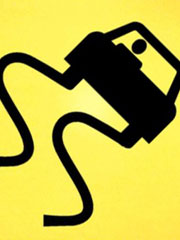Ok, let me start this by saying that i am not an expert on roads or cars or weather.
However, the recent storm system down here has led me to post on this subject.
I've never been able to understand why people cannot drive when the weather is bad. If everyone used common sense and practiced alert driving then the experience of driving in adverse weather and icy conditions is NOT terribly different from driving under normal conditions.
Think about this. If you are an alert driver (meaning you ACTUALLY pay attention to your driving and the road) and you keep your car in reasonably good condition then there is NOTHING your car can do that you shouldn't expect, barring catastrophic mechanical failure. Like any other tool, everything your car does is a direct result of what you are doing.
Repeat: Nothing your car can/will do should surprise you!
That doesn't change when there is a layer of ice on the road. If you park your car on a level, ice-covered parking spot, is it not exactly where you left it when you return? There's no magic, your car isn't going to do anything you don't tell it to do.
I'm not saying you should drive twenty miles an hour over the speed limit, however you should be able to manage more than ten miles an hour.
If you are too scared to drive at least 20-25... you probably have no idea what your car is capable of and should stay home.
As someone who learned how to drive in the Wyoming winter, my early high school years consisted of learning what a car can do in certain conditions. When the roads are icy, you don't necessarily need to slow down THAT much... but you do need to pay attention. It is going to take you much longer to get stopped, so blowing through that yellow light is probably a bad idea.
Yes, i realize there are other drivers out there. And most of them fall into this category of being oblivious to the power of the machine they are riding in. However, the above still applies. As a part of attentive driving you should always have an escape plan to any situation you are driving in.
For instance, in a front-wheel drive car, if you are bearing down on another vehicle and you aren't going to be able to stop... you can always drop a gear, turn the wheel, and change the direction of the car. Just knowing this has saved me a couple of times.
Finally, i'm not going to pretend that accidents aren't going to happen. Sometimes you really do have nowhere to go... but you should be able to anticipate that situation and adjust your speed accordingly IN ADVANCE of the situation.
Again, it all comes back to alert, attentive driving. If you spend most of your drive time while chatting on the cell phone... you should probably stay home when the weather's bad. If you aren't going to drive, let those of us who will drive that much safer.
Personally, i really enjoy driving on bad roads... because i have learned how to drive my car and how to anticipate everything it might do. It really doesn't require a degree in physics. Just remember every action has an equal and opposite reaction and keep that in mind and you'll be just fine.
Also remember, while driving on snow is not the same as driving on pavement or gravel... it is also not the same as driving on ice. Snow is not nearly as slick as ice and gives you a few more options. Just pay attention to what your car is doing and you'll learn that driving is still plenty enjoyable.
And stay out of my way! =^) Seriously, be careful and MINDFUL out there!
What i'm listening to:

Brother Love's Traveling...
Neil Diamond
Brother Love's Traveling...

![]() the winter weather! =^) You should do the same... unless of course it isn't winter where you are.
the winter weather! =^) You should do the same... unless of course it isn't winter where you are. Stop!
Stop!
 Brother Love's Traveling...
Brother Love's Traveling...
 Baby, One More Time
Baby, One More Time
 Rocket Man
Rocket Man
 Dreamaniacs
Dreamaniacs
 What the Hell (I Love This Girl...
What the Hell (I Love This Girl...
 Empty Garden (Hey, Hey Johnny)
Empty Garden (Hey, Hey Johnny)
 Who Wears These Shoes?
Who Wears These Shoes?